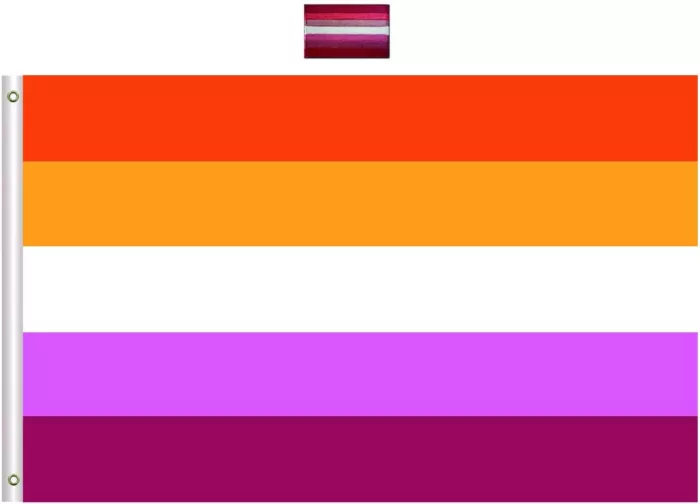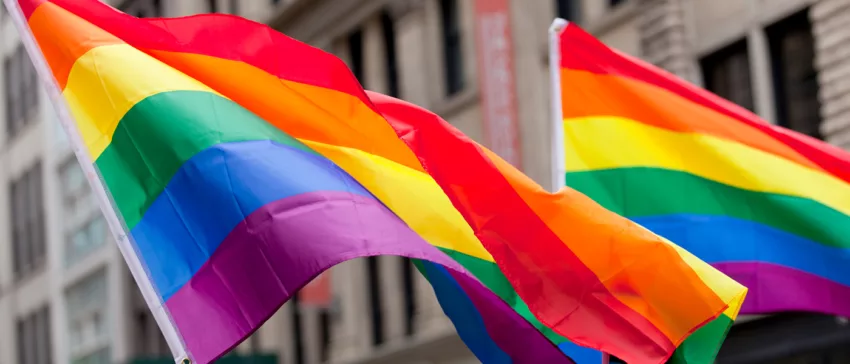The Lesbian Pride Flag, like other pride flags, symbolizes identity, unity, and visibility for the lesbian community, celebrating their experiences and struggles related to their sexual orientation. Its history, while less documented, is part of LGBTQ+ pride flag history. Color meanings vary among individuals and communities, but the flag fosters lesbian community and pride, akin to other LGBTQ+ flags.
Pride flags trace their history to the late 1970s, with the iconic rainbow pride flag by Gilbert Baker in 1978. As the LGBTQ+ community grew, subgroups like lesbians crafted their own flags to represent unique identities.
The Lesbian Pride Flag, a relatively recent symbol, is now vital for lesbians globally, seen at pride events and online. It has evolved in colors and designs, mirroring the diversity within the lesbian community.
Similar read: Dumpor: Discover Hidden Instagram Stories
Table of Contents
The need for a lesbian-specific flag

The creation and use of a lesbian-specific flag address several important needs and purposes within the LGBTQ+ community:
Visibility and Recognition
Having a lesbian-specific flag provides visibility to the lesbian community, helping lesbians to be recognized and celebrated within the broader LGBTQ+ movement. It gives lesbians a distinct symbol and identity that they can rally around, fostering a sense of belonging.
Representation
A lesbian flag represents the unique experiences, history, and struggles faced by lesbians. Just as with any specific identity, it’s important to have symbols that reflect the distinct characteristics of that group. This can help in addressing the erasure or marginalization of lesbians within the larger LGBTQ+ community.
Empowerment
The creation and use of a lesbian flag can be empowering for lesbians, allowing them to express their identity and pride openly. It can serve as a source of strength and support, especially in societies where lesbian identities are stigmatized or marginalized.
Community Building
The flag fosters a sense of community among lesbians. When people can rally around a common symbol, it creates a sense of unity, which can lead to greater social and political activism, as well as support networks within the lesbian community.
Similar read: What Is A Logitech Unifying Software?
Awareness and Education
Lesbian-specific flags can serve as tools for raising awareness about lesbian issues and educating the broader society. The flag’s colors and symbolism can be used to communicate important messages about lesbian identity, history, and challenges.
Inclusivity
The existence of a lesbian flag does not exclude anyone from participating in the LGBTQ+ movement. It adds to the overall diversity and inclusivity within the broader spectrum. It’s important to remember that the LGBTQ+ community is not homogenous, and various identities within it have their own unique symbols and histories.
Solidarity
Pride flags, including the lesbian flag, often serve as symbols of solidarity. They demonstrate support for an alliance with one another and other marginalized communities. They are a reminder that the LGBTQ+ movement is a collective effort for social justice and equality.
Similar read: What Is MusicLM Research Project?
A detailed description of the Lesbian Pride Flag’s design

The Lesbian Pride Flag is characterized by its horizontal stripes of various colors. While there can be some variations in the shade of colors and their order, the most commonly recognized design consists of five horizontal stripes from top to bottom. Here is a detailed description of the design of the Lesbian Pride Flag:
1. Dark Orange or Red-Orange Stripe:
The top stripe, often colored in a dark orange or red-orange shade, represents gender non-conformity and independence within the lesbian community. This color symbolizes those who do not conform to traditional gender roles and norms.
2. Light or Peachy Orange Stripe
Below the dark orange stripe is a lighter shade of orange, often described as peachy. This color represents healing and recovery from past traumas, acknowledging the resilience of lesbians in the face of challenges and discrimination.
3. White Stripe
The middle stripe is white and stands for gender non-conformity, as well as gender diversity and inclusion. It reflects the diversity of gender identities and expressions among lesbians and signifies the importance of recognizing and respecting this diversity.
4. Pink Stripe
Just below the white stripe is a pink stripe that represents love and passion. It symbolizes the romantic and emotional connections that lesbians form, emphasizing the importance of love and emotional well-being within the lesbian community.
Another Pink Stripe or Light Red Stripe
Some variations of the Lesbian Pride Flag include a second pink stripe or a light red stripe immediately following the primary pink stripe. The exact shade may vary in different versions. The additional pink or red stripe is often interpreted as a symbol of community, unity, and solidarity among lesbians.
Similar read: What is Barndominium?
How the flag is incorporated into Pride Month celebrations?

The Lesbian Pride Flag, like other LGBTQ+ pride flags, is an important symbol that is often incorporated into Pride Month celebrations in various ways.
Pride Month, which is celebrated in June in many parts of the world, is a time for the LGBTQ+ community and its allies to come together to celebrate diversity, raise awareness, and advocate for LGBTQ+ rights. Here’s how the Lesbian Pride Flag is typically incorporated into Pride Month celebrations:
Flag Displays
One of the most common ways the Lesbian Pride Flag is incorporated into Pride Month is through the display of flags. It is often hoisted alongside the rainbow Pride Flag, which represents the broader LGBTQ+ community, at pride events, parades, public buildings, and businesses. These flag displays help create a visible and inclusive environment that welcomes and celebrates lesbians and their experiences.
Pride Parades
Pride parades are a central part of Pride Month celebrations. Participants in these parades often carry or wear the Lesbian Pride Flag, showcasing their identity and solidarity with the lesbian community. Large flags are often carried by groups or individuals, and smaller flags can be distributed to onlookers and participants.
Merchandise and Apparel
The Lesbian Pride Flag is commonly featured on a wide range of merchandise, including clothing, accessories, and home décor. During Pride Month, people often wear clothing or accessories featuring the flag’s colors or designs to show their support for the lesbian community.
Events and Activities
Pride Month events, such as festivals, concerts, workshops, and panel discussions, often feature the Lesbian Pride Flag in their promotional materials and decor. It’s a way to create an inclusive and welcoming atmosphere for lesbians and other members of the LGBTQ+ community.
Social Media and Online Engagement
The Lesbian Pride Flag is widely shared on social media platforms during Pride Month. People change their profile pictures to incorporate the flag, share educational content about lesbian issues, and use Pride Month hashtags to raise awareness and show their support.
Similar read: What is Mediafire?
Public and Community Spaces
Public spaces, such as parks, streets, and buildings, are often decorated with the Lesbian Pride Flag during Pride Month. Additionally, community organizations and LGBTQ+ centers may incorporate the flag into their facilities and signage.
Educational Initiatives
Pride Month provides an opportunity to educate the public about LGBTQ+ history, issues, and experiences. The Lesbian Pride Flag is often used in educational materials and displays to help teach people about the specific struggles and identities within the LGBTQ+ community.
Advocacy and Activism
Pride Month is a time for advocacy and activism, and the Lesbian Pride Flag is a symbol of the issues and rights that lesbians and the broader LGBTQ+ community are fighting for. Activists often use the flag in demonstrations, rallies, and campaigns to promote equality and social change.
- What is Epic Games Launcher and How to Install It? - July 15, 2024
- What Is Audius Music Streaming App and How Does it Work? - July 13, 2024
- The 10 Best Astronomy Apps for Stargazing - July 12, 2024

